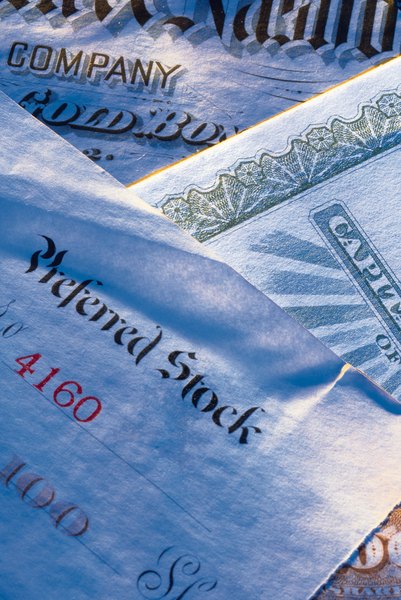How to Buy Preferred Shares of Stock
Preferred stock owners receive fixed dividends paid regularly.
Comstock/Comstock/Getty Images
You can buy preferred shares of any publicly traded company in the same way you buy common shares: through your broker, whether online through a discount broker or by contacting your personal broker at a full-service brokerage. The more relevant issue is: what exactly you're buying and why you should (or shouldn't) buy a company's preferred shares over its common stock.
Tip
You can purchase preferred shares of a listed company using a variety of brokerage services.
The Difference Between Preferred and Common Shares
When you buy shares of a company's common stock, you've become one of the owners of the company. With your common stock purchase, you also acquire voting rights proportional to your ownership. In some cases, owners of common stock have voted out one or more members of the company's board of directors, even forcing the replacement of the existing CEO. Owners of preferred shares almost never acquire voting rights.
On the other hand, as an owner of common shares, not only are you not guaranteed a particular dividend amount; you may not be entitled to a dividend at all – that's entirely up to the company's board of directors, as is the dividend amount if one is declared.
Preferred Shares and Dividends
When you buy preferred shares, you're guaranteed regular distributions of dividends at a rate guaranteed at the time of issuance, unless the company's fortunes decline to a point where paying the dividend is no longer possible. Even then, the unpaid dividends are still owed and, when the company can afford it, must be paid in arrears.
If worst comes to worst, and the company goes bankrupt, preferred shareholders are entitled to be repaid their investment in full before common stockholders can receive anything at all. As a practical matter, when a company liquidates, preferred shareholders may or may not recoup all or part of their investment, but common shareholders often receive nothing.
Why Buy Preferred Shares?
For individual retail investors, the answer might be "for no very good reason." It's not generally known, but most preferred shares are purchased by institutional investors at the time the company first goes public because they have an incentive to buy preferred shares that individual retail investors do not: the so-called "dividend received deduction." This IRS ruling entitles institutions that pay corporate income taxes a 70 percent exclusion of that income from taxes – a huge benefit. Lacking this generous incentive, preferred shares become less attractive to the individual investors.
Nonetheless, there can be a place for preferred shares in a diversified investment portfolio. One way of looking at them is not so much as an alternative to common stock, but as an equity related to a bond. Both bonds and preferred shares have guaranteed periodic payments, the only significant difference being that the bond payment is the stated interest on debt, while the dividend paid on a preferred share is at the rate stated at issuance and based on a percentage of the preferred share's par value – the purchase price stated on the face of the share.
Another characteristic both equities share is their lower volatility compared to common stock. This is particularly true for bonds with limited maturities as well as for the preferred shares of Dow Jones 30 and Fortune 500 companies, the behemoths of capitalism.
Preferred shares are particularly suited to the portfolios of wealthy investors, where the relative stability of the investment is more important than the greater average returns on investment of common stock.
References
Tips
- Preferred stock symbols are different from common stock symbols, so be sure to enter the correct symbol when placing your trade.
Warnings
- Finding information about a preferred stock can be difficult. Go to the company website or contact your broker to get the information you need to make an informed decision.
Writer Bio
I am a retired Registered Investment Advisor with 12 years experience as head of an investment management firm. I also have a Ph.D. in English and have written more than 4,000 articles for regional and national publications.

